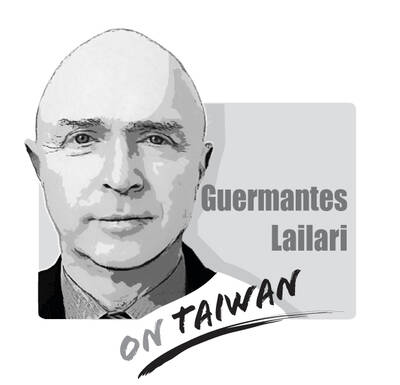The army will be able to upgrade its artillery now that the US Department of State has approved a sale to Taiwan of 108 M1A2 Abrams tanks and other defense equipment, the Liberty Times (the Taipei Times’ sister newspaper) reported on July 12.
The military asked to purchase more than 100 155mm M109A6 Paladin self-propelled howitzers from the US for about NT$30 billion (US$966 million) and submitted its plans to the Executive Yuan for review.
It wants the howitzers to replace its aging M109A2 and M109A5s, M110A2 8-inch self-propelled howitzers and 155mm M114 towed howitzers.
My initial reaction to the news was a mixture of delight and concern. Delight that the generals have finally decided to retire aging artillery pieces that have been in service for 20 to 50 years; concern because tracked, self-propelled artillery — which Paladin howitzers are — are comparatively expensive.
There will only be enough to replace approximately one-eighth of the army’s artillery pieces. This is utterly inadequate. As the government has not officially placed an order with the US, there is still time to learn from other nations’ experiences and adjust the procurement plan to take into account developing trends.
Taiwan has the highest density of public roads of almost any country in the world.
Ministry of Transport and Communications data from 2015 showed that Taiwan has 41,950km of public roads, or 11.2km of road for every square kilometer of land. Taiwan’s density is higher than that of many other developed nations, eclipsed only by Singapore, the Netherlands and Belgium. Given this, generals should not overlook wheeled self-propelled artillery for the army’s infantry and mechanized artillery divisions.
The greatest advantage of the wheeled options is cost: They are not only cheaper, but also more economical to maintain, while they are perfectly suited to Taiwan’s high road density.
Many years ago, the army considered buying South African-produced G5 wheeled howitzers, which have twice the effective range of its M109A3/A5s and M114s.
Unfortunately, after South Africa broke diplomatic relations with Taiwan, the purchase plan fell by the wayside.
A US Defense Security Cooperation Agency report details how last year Saudi Arabia upgraded to Paladin howitzers at a cost of US$1.3 billion. As Taiwan plans to buy more than 100, the total would be close to NT$30 billion.
The French-made CAESAR and Israeli-produced ATMOS 2000 are the world’s best-selling wheeled self-propelled howitzers. Both are nearly identical to the US-made Paladins — the design of which dates back to the 1960s — but the CAESAR and ATMOS 2000 are much better value for money.
In 2016, Thailand’s military selected the ATMOS 2000 and in 2017, Denmark chose a modified 8x8 version of the CAESAR for its armed forces. Israel’s military chose the ATMOS 2000.
Both of these can be purchased for one-fifth the price of a Paladin. For about the same outlay, Taiwan’s military would be able to replace more than half of its artillery pieces with either the CAESAR or ATMOS 2000.
This is surely a more rational way to modernize Taiwan’s outdated artillery.
Chang Feng-lin is a doctoral student.
Translated by Edward Jones
A response to my article (“Invite ‘will-bes,’ not has-beens,” Aug. 12, page 8) mischaracterizes my arguments, as well as a speech by former British prime minister Boris Johnson at the Ketagalan Forum in Taipei early last month. Tseng Yueh-ying (曾月英) in the response (“A misreading of Johnson’s speech,” Aug. 24, page 8) does not dispute that Johnson referred repeatedly to Taiwan as “a segment of the Chinese population,” but asserts that the phrase challenged Beijing by questioning whether parts of “the Chinese population” could be “differently Chinese.” This is essentially a confirmation of Beijing’s “one country, two systems” formulation, which says that

“History does not repeat itself, but it rhymes” (attributed to Mark Twain). The USSR was the international bully during the Cold War as it sought to make the world safe for Soviet-style Communism. China is now the global bully as it applies economic power and invests in Mao’s (毛澤東) magic weapons (the People’s Liberation Army [PLA], the United Front Work Department, and the Chinese Communist Party [CCP]) to achieve world domination. Freedom-loving countries must respond to the People’s Republic of China (PRC), especially in the Indo-Pacific (IP), as resolutely as they did against the USSR. In 1954, the US and its allies
Indian Prime Minister Narendra Modi arrived in China yesterday, where he is to attend a summit of the Shanghai Cooperation Organization (SCO) with Chinese President Xi Jinping (習近平) and Russian President Vladimir Putin today. As this coincides with the 50 percent US tariff levied on Indian products, some Western news media have suggested that Modi is moving away from the US, and into the arms of China and Russia. Taiwan-Asia Exchange Foundation fellow Sana Hashmi in a Taipei Times article published yesterday titled “Myths around Modi’s China visit” said that those analyses have misrepresented India’s strategic calculations, and attempted to view
When Chinese President Xi Jinping (習近平) stood in front of the Potala Palace in Lhasa on Thursday last week, flanked by Chinese flags, synchronized schoolchildren and armed Chinese People’s Liberation Army (PLA) troops, he was not just celebrating the 60th anniversary of the establishment of the “Tibet Autonomous Region,” he was making a calculated declaration: Tibet is China. It always has been. Case closed. Except it has not. The case remains wide open — not just in the hearts of Tibetans, but in history records. For decades, Beijing has insisted that Tibet has “always been part of China.” It is a phrase